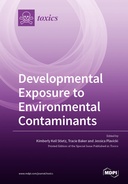Explore

Developmental Exposure to Environmental Contaminants
0 Ungluers have
Faved this Work
Login to Fave
Development provides an especially sensitive window whereby environmental contaminants can have significant and lasting effects on the morphology and function of many organs and systems. The importance of understanding developmental effects of environmental contaminants extends not only to developmental stages, but also to encompass the hypotheses of the developmental or fetal origins of adult disease. Such effects of environmental contaminants during development extend to health outcomes that can persist in adulthood, first become apparent in adulthood, or manifest in adulthood but only after a second hit/stressor. The diverse nature of possible environmental contaminants, ranging from persistent organic pollutants to emerging contaminants of concern, along with the diverse range of health implications, including autism, diabetes, cancer, infertility, and lower urinary tract function, make understanding developmental effects of environmental contaminants an ever growing and important field of study.This Special Issue aims to explore a variety of topics in line with the aims and scope of Toxics. Specifically, topics related to the developmental effects of environmental contaminants and/or their metabolites on the molecular, cellular, tissue, organ, organ system or organism, including mechanisms of toxicity, metabolism, risk assessment and management, as well as multiple stressor impacts in the context of aging or disease progression following developmental exposures.
This book is included in DOAB.
Why read this book? Have your say.
You must be logged in to comment.
Rights Information
Are you the author or publisher of this work? If so, you can claim it as yours by registering as an Unglue.it rights holder.Downloads
This work has been downloaded 95 times via unglue.it ebook links.
- 95 - pdf (CC BY) at Unglue.it.
Keywords
- 4-nonylphenol
- aquatic environment
- Aroclor 1221 (A1221)
- arsenic
- axonal growth
- Behavior
- Bladder
- BPH
- bronchopulmonary dysplasia
- chemical screening
- Danio rerio
- detergents
- Development
- developmental basis of adult disease
- developmental neurotoxicity
- developmental toxicity
- dysmetabolism
- endocrine-disrupting chemical (EDC)
- endocrine-disrupting chemicals (EDC)
- environmental toxicity
- epigenetic
- epigenetics
- estradiol
- fluoxetine
- ground water chemicals
- Hippocampus
- Inflammation
- intestinal dysbiosis
- literature comparison
- long-term potentiation
- lower urinary tract
- lower urinary tract dysfunction
- lower urinary tract symptoms
- lung development
- mating behavior
- Medical Toxicology
- medicine
- Microglia
- Multigenerational
- negative control
- neonatal morbidity
- neuronal morphogenesis
- Other branches of medicine
- paced mating
- PBDE
- PCBs
- perigestational
- perinatal mortality
- Pesticides
- PFAS
- PFAS mixtures
- Pharmacology
- polychlorinated biphenyl (PCB)
- POPs
- positive control
- Prebiotic
- primary motor cortex
- Prostate
- rapid testing
- Reactive Oxygen Species
- risk factor
- selective serotonin reuptake inhibitor
- sertraline
- Sex differences
- Social Behavior
- Synaptic Transmission
- Therapeutics
- thyroid hormone
- toxicants
- transgenerational
- triclocarbon
- triclosan
- ultrasonic vocalization (USV)
- valproic acid
- vinclozolin
- Zebrafish
Links
DOI: 10.3390/books978-3-0365-5885-1Editions

